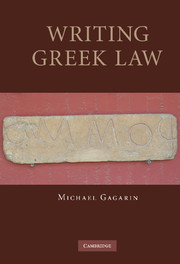Book contents
- Frontmatter
- Contents
- List of illustrations
- Preface and Acknowledgments
- List of abbreviations
- Introduction: Writing Greek Law
- Chapter 1 Law before Writing
- Chapter 2 Writing and Written Laws
- Chapter 3 Why the Greeks Wrote Laws
- Chapter 4 Why Draco Wrote his Homicide Law
- Chapter 5 Oral and Written in Archaic Greek Law
- Chapter 6 Writing Laws in Fifth-Century Gortyn
- Chapter 7 Writing the Gortyn Code
- Chapter 8 Writing Law in Classical Athens
- Chapter 9 Writing Athenian Law: a Comparative Perspective
- Chapter 10 Writing Law in Hellenistic Greece
- Conclusion: Writing Greek Law
- Appendices
- Bibliography
- Index Locorum
- Subject Index
Conclusion: Writing Greek Law
Published online by Cambridge University Press: 22 September 2009
- Frontmatter
- Contents
- List of illustrations
- Preface and Acknowledgments
- List of abbreviations
- Introduction: Writing Greek Law
- Chapter 1 Law before Writing
- Chapter 2 Writing and Written Laws
- Chapter 3 Why the Greeks Wrote Laws
- Chapter 4 Why Draco Wrote his Homicide Law
- Chapter 5 Oral and Written in Archaic Greek Law
- Chapter 6 Writing Laws in Fifth-Century Gortyn
- Chapter 7 Writing the Gortyn Code
- Chapter 8 Writing Law in Classical Athens
- Chapter 9 Writing Athenian Law: a Comparative Perspective
- Chapter 10 Writing Law in Hellenistic Greece
- Conclusion: Writing Greek Law
- Appendices
- Bibliography
- Index Locorum
- Subject Index
Summary
We have come to the end of the story of writing Greek law, which begins in a period of oral law in which writing played no role, and continues through the earliest use of writing in the seventh century for recording and making public legislation, into the classical and Hellenistic periods when writing was increasingly used in the administration of law and for legal documents other than laws, and ends (for us) in Ptolemaic Egypt, where writing law changes entirely. With the exception of Egypt, we have seen two trends consistently at work: the abundant use of writing for legislation, which was always publicly displayed so as to be read and used by a relatively large segment of the community, and the resistance to using writing during the judicial process. We have also noted some of the consequences of these two trends – that Greek laws have a more open texture, a broader “fringe of vagueness” (Hart 1994: 123) than modern laws, that they are generally written in ordinary, non-technical language, and that the legal professionals so prominent in most other legal systems, including lawyers, notaries, judges, and jurists, are largely absent from Greek law.
All these features worked to make Greek law accessible to a relatively broad segment of the community.
- Type
- Chapter
- Information
- Writing Greek Law , pp. 242 - 247Publisher: Cambridge University PressPrint publication year: 2008

